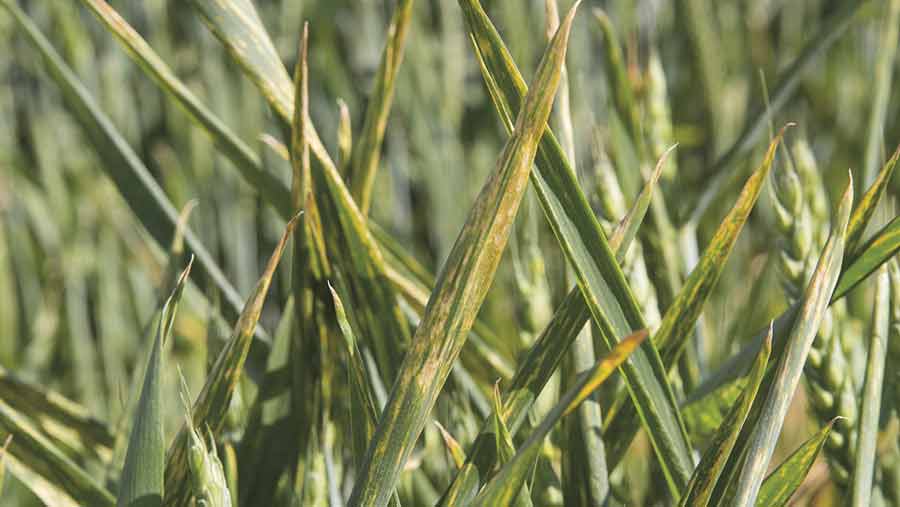Why experts changed how yellow rust strains are named
Researchers are taking a similar approach to naming yellow rust strains as they are for potato blight strains.
Major changes to the way that yellow rust races are to be named reflects the enormous diversity that is being found in the UK wheat yellow rust population.
The changes aim to give farmers and advisers better information on the risk the different strains present.
From now on, a combination of colours and numbers will be used – similar to that done with potato blight strains – so that both genotype and pathotypic data is indicated.
See also: Yorkshire yellow rust may warrant wheat pre-T0 fungicide
This means that the new “Invicta” race, which was discovered in 2016, will be known as WYR Blue 7, confirms Sarah Holdgate of Niab Tag, who manages the UK Cereals Pathogen Virulence Survey (UKCPVS) disease monitoring project.
“What we found in 2016 was that some yellow rust isolates were so diverse, that they behaved differently in the field to what was expected of them,” she says.
“It meant that some previously resistant varieties [of wheat] developed levels of infection, taking growers by surprise.”

© Tim Scrivener
The differences between these isolates and their effect on resistance genes can only be detected by using both pathotype and genotype, which is why the naming system had to be developed, she adds.
“We will be providing additional information with the colour and number combinations, so that growers are aware of the varieties that are affected by the different races.”
The previous system used the susceptible wheat variety name to identify the race, with titles such as the Solstice, Warrior, Kranich and Invicta races being used in recent years.
“That is no longer an accurate way of classifying them or communicating how they will behave in the field,” notes Dr Holdgate.
“So we will be using red for Warrior 4, pink for Warrior 1, blue for Warrior 3 and purple for Kranich, along with the appropriate numbers.”
Findings from 2016
The 2016 season proved to be an exceptional year for yellow rust, with very high levels of disease being recorded.
As a result, changes were made to varietal resistance ratings, with seven recommended winter wheat varieties seeing their ratings drop by two points or more.
New rust isolates identified in 2015 and 2016 may have been responsible for this, acknowledges Dr Holdgate, but there’s no evidence to date to show that these are more aggressive in the field.
“In 2017, we will be looking at isolates as they come in, so that we can note their time to sporulation for future aggressiveness tests and see if there is any difference in their latent periods.”
More aggressive races have existed in Europe since the early 2000s, but have not been found in the UK, she emphasises.
A more likely explanation for 2016 is that there was a high spore load carried over from 2015, which was then followed by a mild autumn and winter. The new races then caused a change in the virulence profile for certain varieties.
Complex situation
Frequent reports of higher than expected levels of disease meant that the current Recommended List ratings were calculated using 2016 data only, rather than from three years.
“That gave the best ratings to reflect the disease levels being seen and is as accurate as we can be.”
Growers must remember that the yellow rust situation is very complex, she adds.
“Populations do change and it becomes increasingly difficult to classify them. There’s bound to be something that comes up in the future to test the system.”
As a result, anything unusual should be sent as a sample to UKCPVS for testing. Full details of how to do this are on the Niab website.
Variety Update
While 19 out of 36 Recommended List varieties have good adult plant resistance – which is impressive given the diversity of the yellow rust population – only three of these were also resistant at the seedling stage.
“The only varieties which aren’t susceptible at any stage are Costello, Crispin and Siskin,” reveals Amelia Hubbard of Niab.
“They have good overall resistance to yellow rust.”
Varieties showing infection at the seedling stage for the first time included Evolution, Silverstone and Illustrious – although not all of them were susceptible to all of the five isolates.
Adult plant resistance kicks in at different stages in individual varieties, she notes.
In 2016, 340 yellow rust samples were received by Niab, with 33 of them coming from Reflection.
Races
The Warrior race continued to dominate the samples received in 2016, with the Warrior 4 group (red) being found at the highest frequency.
After a period of decline, Warrior 1 (pink) increased slightly.
Despite high disease levels in 2016, no unexpected brown rust disease was reported, but investigations into the race affecting Crusoe will continue.
Virulence frequencies for mildew remained similar to those seen in previous years.

